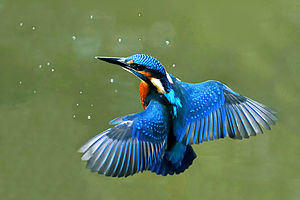Tal der Eisvögel - Kingfisher's Valley EarthCache
Tal der Eisvögel - Kingfisher's Valley
-
Difficulty:
-

-
Terrain:
-

Size:  (other)
(other)
Please note Use of geocaching.com services is subject to the terms and conditions
in our disclaimer.
Der Stuersche Bach durchschneidet in seinem Gesamtverlauf vom Kogeler See über die Vordermühle bis zur Mündung in den Plauer See einen Endmoränenzug. In den Steilwänden befinden sich die Nisthöhlen der Eisvögel.
The end moraine near Bad Stuer Vordermuehle has been cut into two by the river "Stuerscher Bach". Thus it has created a valley and a high cliff in which kingfishers have settled down. Lots of nests can be seen in the cliff.


Moränen (v. frz.: moraine „Geröll“) sind die Gesamtheit des vom Gletscher transportierten Materials, im speziellen die Schuttablagerungen, die von Gletschern bei ihrer Bewegung mitbewegt oder aufgehäuft werden, sowie die im Gelände erkennbaren Formationen.
Endmoränen bilden sich als Schuttanhäufung am Gletscherende, wenn sich die Gletscherstirn für längere Zeit nicht bewegt. An ihnen kann man besonders gut die größte Ausdehnung des Gletschers erkennen.
Aufgaben: macht ein Foto von euch/dem GPS vor der Steilwand und sendet es mit den Antworten der folgenden Fragen an uns.
1. Aus welchem Material besteht die Steilwand?
2. Welche anderen Vögel nisten in ihr? (mindestens zwei Arten)
Bitte uns die Antworten mailen! Viel Erfolg!

Moraine refers to any glacially formed accumulation of unconsolidated debris which can occur in currently glaciated and formerly glaciated regions, such as those areas acted upon by a past ice age. This debris may have been plucked off the valley floor as a glacier advanced or fallen off the valley walls as a result of frost wedging. Moraines may be composed of silt like glacial flour to large boulders. The debris is typically angular. Moraines may be on the glacier’s surface or deposited as piles or sheets of debris where the glacier has melted. Moraines may also occur when glacier or iceberg transported rocks fall into the sea as the ice melts. End moraines or terminal moraines are ridges of unconsolidated debris deposited at the snout or end of the glacier. They usually reflect the shape of the glacier's terminus. Glaciers act much like a conveyor belt carrying debris from the top of the glacier to the bottom where it deposits it in end moraines.
End moraine size and shape is determined by whether the glacier is advancing, receding or at equilibrium. The longer the terminus of the glacier stays in one place the more accumulation there will be. There are two types of end moraines, terminal and recession moraines. Terminal moraines mark the maximum advance of the glacier. Recessional moraines are small ridges left as a glacier pauses during its retreat. After a glacier retreats the end moraine may be destroyed by postglacial erosion.
Tasks: Please take a photo of the cliff and a GPS device. Send an email and answer the following questions as well:
1. What is the material that the steep wall consists of?
2. Which other birds live in the cliff? (name two, please)
Please email us the answers! Good luck!
Additional Hints
(Decrypt)
Sentg ibe Beg anpu qrz Gny bqre fhpug anpu Orfpuvyqrehat!